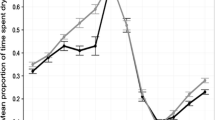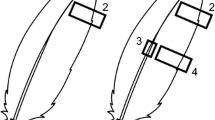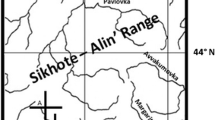Abstract
To determine whether stable isotope measurements of body feathers can be used to investigate the isotopic niche of moulting (inter-nesting) adult seabirds, we examined the stable carbon (δ13C) and nitrogen (δ15N) isotopic composition of body feathers of breeding wandering albatrosses (Diomedea exulans) from Crozet Islands, southern Indian Ocean. First we showed that the isotopic composition of body feathers was not significantly different from that of wing feathers, being thus a safe alternative to flight feathers whose collection impairs the birds’ flying ability. Second, we looked at the variances in δ13C and δ15N values resulting from the isotopic measurement of a single feather, four different feathers, and a pool of four feathers per bird, to delineate the best isotopic analytical procedure. A two-step protocol is proposed that allows investigating both the intra- and inter-individual components of the niche width of the species. In a first step, isotopic measurements on a single feather per bird are used to define isotopic specialist from isotopic generalist populations. In a second step and for generalist populations only, measurements on additional (three) feathers per bird are used to delineate type A from type B isotopic generalists (Bearhop et al. in J Anim Ecol 73:1007–1012, 2004). Third, from a biological point of view, our data showed different moulting isotopic niches for adult males and females, and also within female wandering albatrosses. Since the isotopic composition of body feathers in this species reflects that of wing feathers, our results suggest that, after validation, body feathers have the potential for investigating the foraging ecology of other Procellariiforms and seabirds during the poorly known inter-nesting period.



Similar content being viewed by others
References
Barbraud C, Weimerskirch H (2003) Climate and density shape population dynamics of a marine top predator. Proc R Soc Lond B Biol Sci 270:2111–2116. doi:https://doi.org/10.1098/rspb.2003.2488
Bearhop S, Thompson DR, Waldron S, Russell IC, Alexander G, Furness RW (1999) Stable isotopes indicate the extent of freshwater feeding by cormorants Phalacrocorax carbo shot at inland fisheries in England. J Appl Ecol 36:75–84. doi:https://doi.org/10.1046/j.1365-2664.1999.00378.x
Bearhop S, Phillips RA, Thompson DR, Waldron S, Furness RW (2000) Variability in mercury concentrations of great skuas Catharacta skua: the influence of colony, diet and trophic status inferred from stable isotope signatures. Mar Ecol Prog Ser 195:261–268. doi:https://doi.org/10.3354/meps195261
Bearhop S, Waldron S, Votier SC, Furness RW (2002) Factors that influence assimilation rates and fractionation of nitrogen and carbon stable isotopes in avian blood and feathers. Physiol Biochem Zool 75:451–458. doi:https://doi.org/10.1086/342800
Bearhop S, Adams CE, Waldron S, Fuller RA, MacLeod H (2004) Determining trophic niche width: a novel approach using stable isotope analysis. J Anim Ecol 73:1007–1012. doi:https://doi.org/10.1111/j.0021-8790.2004.00861.x
Becker BH, Newman SH, Inglis S, Beissinger SR (2007) Diet-feather stable isotope (δ15N and δ13C) fractionation in common murres and other seabirds. Condor 109:451–456. doi:https://doi.org/10.1650/0010-5422(2007)109[451:DSINAC]2.0.CO;2
BirdLife International (2008) http://www.birdlife.org/
Bolnick DI, Svanbäck R, Fordyce JA, Yang LH, Davis JM, Hulsey CD, Forister ML (2003) The ecology of individuals: incidence and implications of individual specialization. Am Nat 161:1–28. doi:https://doi.org/10.1086/343878
Bridge ES (2006) Influences of morphology and behavior on wing-molt strategies in seabirds. Mar Ornithol 34:7–19
Cherel Y, Hobson KA (2007) Geographical variation in carbon stable isotope signatures of marine predators: a tool to investigate their foraging areas in the Southern Ocean. Mar Ecol Prog Ser 329:281–287. doi:https://doi.org/10.3354/meps329281
Cherel Y, Hobson KA, Weimerskirch H (2000) Using stable-isotope analysis of feathers to distinguish moulting and breeding origins of seabirds. Oecologia 122:155–162. doi:https://doi.org/10.1007/PL00008843
Cherel Y, Bocher P, Trouve C, Weimerskirch H (2002) Diet and feeding ecology of blue petrels Halobaena caerulea at Iles Kerguelen, Southern Indian Ocean. Mar Ecol Prog Ser 228:283–299. doi:https://doi.org/10.3354/meps228283
Cherel Y, Phillips RA, Hobson KA, McGill R (2006) Stable isotope evidence of diverse species-specific and individual wintering strategies in seabirds. Biol Lett 2:301–303. doi:https://doi.org/10.1098/rsbl.2006.0445
Cherel Y, Hobson KA, Guinet C, Vanpé C (2007) Stable isotopes document seasonal changes in trophic niches and winter foraging individual specialisation in diving predators from the Southern Ocean. J Anim Ecol 76:826–836. doi:https://doi.org/10.1111/j.1365-2656.2007.01238.x
Cherel Y, Le Corre M, Jaquemet S, Ménard F, Richard P, Weimerskirch H (2008) Resource partitioning within a tropical seabird community: new information from stable isotopes. Mar Ecol Prog Ser 366:281–291. doi:https://doi.org/10.3354/meps07587
Croxall JP, Silk JRD, Phillips RA, Afanasyev V, Briggs DR (2005) Global circumnavigations: tracking year-round ranges of nonbreeding albatrosses. Science 307:249–250. doi:https://doi.org/10.1126/science.1106042
Davoren GK, Montevecchi WA, Anderson JT (2002) Scale-dependent associations of predators and prey: constraints imposed by flightlessness of common murres. Mar Ecol Prog Ser 245:259–272. doi:https://doi.org/10.3354/meps245259
François R, Altabet MA, Goericke R (1993) Changes in the δ13C of surface water particulate matter across the Subtropical Convergence in the SW Indian Ocean. Global Biogeochem Cycles 7:627–644. doi:https://doi.org/10.1029/93GB01277
Grémillet D, Wilson RP, Wanless S, Chater T (2000) Black-browed albatrosses, international fisheries and the Patagonian shelf. Mar Ecol Prog Ser 195:269–280. doi:https://doi.org/10.3354/meps195269
Grosbois V, Thompson PM (2005) North Atlantic climate variation influences survival in adult fulmars. Oikos 109:273–290. doi:https://doi.org/10.1111/j.0030-1299.2005.13774.x
Hebert CE, Bur M, Sherman D, Shutt JL (2008) Sulfur isotopes link overwinter habitat use and breeding condition in double-crested cormorants. Ecol Appl 18:561–567. doi:https://doi.org/10.1890/07-1278.1
Hedd A, Montevecchi WA (2006) Diet and trophic position of Leach’s storm-petrel Oceanodroma leucorhoa during breeding and moult, inferred from stable isotope analysis of feathers. Mar Ecol Prog Ser 322:291–301. doi:https://doi.org/10.3354/meps322291
Hobson KA, Clark RG (1992) Assessing avian diets using stable isotopes I: turnover of 13C in tissues. Condor 94:181–188. doi:https://doi.org/10.2307/1368807
Jardine TD, Cunjak RA (2005) Analytical error in stable isotope ecology. Oecologia 144:528–533. doi:https://doi.org/10.1007/s00442-005-0013-8
Lessells CM, Boag PT (1987) Unrepeatable repeatabilities: a common mistake. Auk 104:116–121
McCutchan JH, Lewis WM, Kendall C, McGrath CC (2003) Variation in trophic shift for stable isotope ratios of carbon, nitrogen, and sulfur. Oikos 102:378–390. doi:https://doi.org/10.1034/j.1600-0706.2003.12098.x
Mill AC, Sweeting CJ, Barnes C, Al-Habsi SH, MacNeil MA (2008) Mass-spectrometer bias in stable isotope ecology. Limnol Oceanogr Methods 6:34–39
Newsome SD, Martinez del Rio C, Bearhop S, Phillips DL (2007) A niche for isotopic ecology. Front Ecol Environ 5:429–436
Nicholls DG, Murray D, Battam H, Robertson G, Moors P, Butcher E, Hildebrandt M (1995) Satellite tracking of the wandering albatross Diomedea exulans around Australia and in the Indian Ocean. Emu 95:223–230
Norris DR, Arcese P, Preikshot D, Bertram DF, Kyser TK (2007) Diet reconstruction and historic population dynamics in a threatened seabird. J Appl Ecol 44:875–884. doi:https://doi.org/10.1111/j.1365-2664.2007.01329.x
Park YH, Gambéroni L (1997) Cross-frontal exchange of Antarctic Intermediate Water and Antarctic Bottom Water in the Crozet Basin. Deep Sea Res Part II Top Stud Oceanogr 44:963–986. doi:https://doi.org/10.1016/S0967-0645(97)00004-0
Pinaud D, Cherel Y, Weimerskirch H (2005) Effect of environmental variability on habitat selection, diet, provisioning behaviour and chick growth in yellow-nosed albatrosses. Mar Ecol Prog Ser 298:295–304. doi:https://doi.org/10.3354/meps298295
Prince PA, Croxall JP, Trathan PN, Wood AG (1998) The pelagic distribution of South Georgia albatrosses and their relationships with fisheries. In: Robertson G, Gales R (eds) Albatross biology and conservation. Surrey Beatty and Sons, Chipping Norton, Australia, pp 137–167
Quillfeldt P, McGill RAR, Furness RW (2005) Diet and foraging areas of Southern Ocean seabirds and their prey inferred from stable isotopes: review and case study of Wilson’s storm-petrel. Mar Ecol Prog Ser 295:295–304. doi:https://doi.org/10.3354/meps295295
Rolland V, Barbraud C, Weimerskirch H (2008) Combined effects of fisheries and climate on a migratory long-lived marine predator. J Appl Ecol 45:4–13
Thompson DR, Furness RW (1995) Stable-isotope ratios of carbon and nitrogen in feathers indicate seasonal dietary shifts in northern fulmars. Auk 112:493–498
Thompson DR, Furness RW, Lewis SA (1995) Diets and long-term changes in δ15N and δ13C values in northern fulmars Fulmarus glacialis from two northeast Atlantic colonies. Mar Ecol Prog Ser 125:3–11. doi:https://doi.org/10.3354/meps125003
Tickell WLN (1968) The biology of the great albatrosses Diomedea exulans and D. epomophora. Antarct Res Ser 12:1–55
Trull TW, Armand L (2001) Insights into Southern Ocean carbon export from the δ13C of particles and dissolved inorganic carbon during the SOIREE iron release experiment. Deep Sea Res Part II Top Stud Oceanogr 48:2655–2680. doi:https://doi.org/10.1016/S0967-0645(01)00013-3
Warham J (1990) The petrels: their ecology and breeding systems. Academic Press, London
Warham J (1996) The behaviour population biology and physiology of the petrels. Academic Press, London
Weimerskirch H (1991) Sex-specific differences in molt strategy in relation to breeding in the wandering albatross. Condor 93:731–737. doi:https://doi.org/10.2307/1368205
Weimerskirch H, Jouventin P (1987) Population dynamics of the wandering albatross, Diomedea exulans, of the Crozet Islands: causes and consequences of the population decline. Oikos 49:315–322. doi:https://doi.org/10.2307/3565767
Weimerskirch H, Wilson RP (2000) Oceanic respite for wandering albatrosses. Nature 406:955–956. doi:https://doi.org/10.1038/35023068
Weimerskirch H, Jouventin P, Mougin JL, Stahl JC, Van Beveren M (1985) Banding recoveries and the dispersal of seabirds breeding in French Austral and Antarctic Territories. Emu 85:22–33
Weimerskirch H, Salamolard M, Sarrazin F, Jouventin P (1993) Foraging strategy of wandering albatrosses through the breeding season: a study using satellite telemetry. Auk 110:325–342
Weimerskirch H, Chastel O, Ackermann L (1995) Adjustment of parental effort to manipulated foraging ability in a pelagic seabird, the thin-billed prion Pachyptila belcheri. Behav Ecol Sociobiol 36:11–16. doi:https://doi.org/10.1007/BF00175723
Weimerskirch H, Cherel Y, Cuénot-Chaillet F, Ridoux V (1997) Alternative foraging strategies and resource allocation by male and female wandering albatrosses. Ecology 78:2051–2063
Acknowledgments
We thank G. Guillou for running stable isotope samples. The present work was supported financially and logistically by the program REMIGE-ANR Biodiversité 2005-011, the Institut Polaire Français Paul Emile Victor (IPEV, programme no. 109, H. Weimerskirch), and the Terres Australes et Antarctiques Françaises (TAAF).
Author information
Authors and Affiliations
Corresponding author
Additional information
Communicated by S. Garthe.
Rights and permissions
About this article
Cite this article
Jaeger, A., Blanchard, P., Richard, P. et al. Using carbon and nitrogen isotopic values of body feathers to infer inter- and intra-individual variations of seabird feeding ecology during moult. Mar Biol 156, 1233–1240 (2009). https://doi.org/10.1007/s00227-009-1165-6
Received:
Accepted:
Published:
Issue Date:
DOI: https://doi.org/10.1007/s00227-009-1165-6




